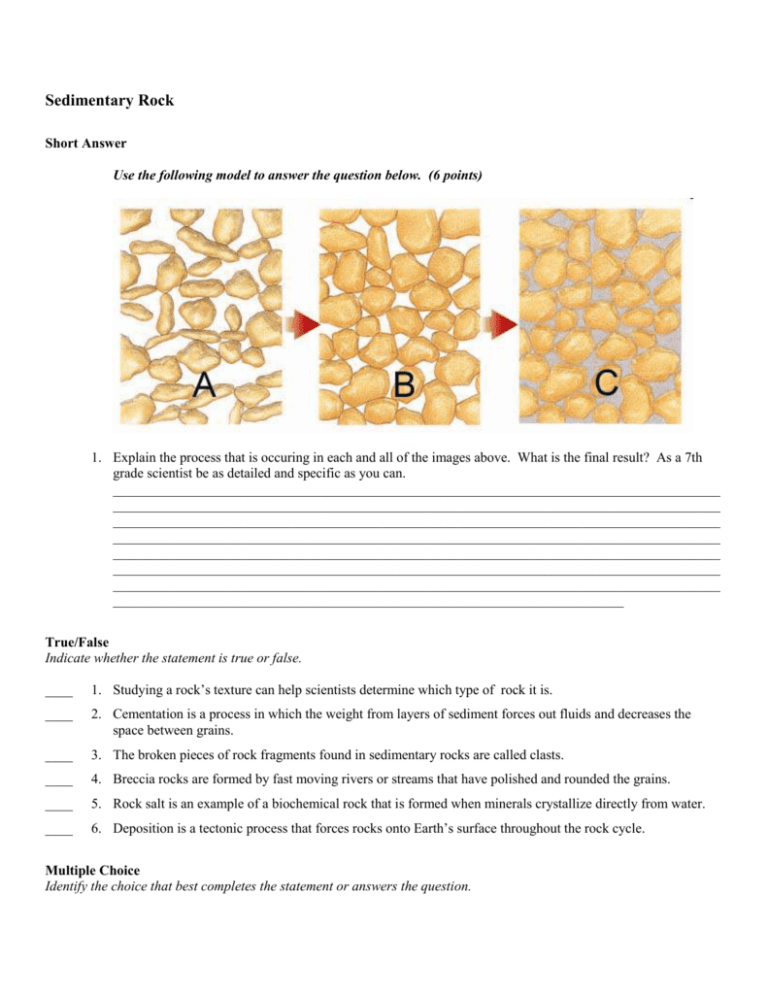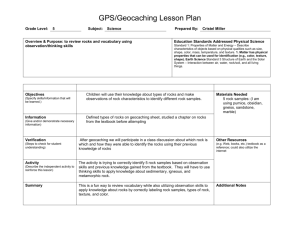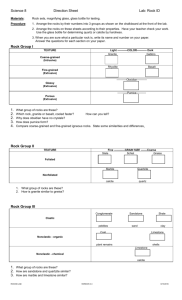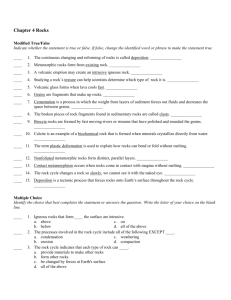Sedimentary Rock
advertisement

Sedimentary Rock Short Answer Use the following model to answer the question below. (6 points) 1. Explain the process that is occuring in each and all of the images above. What is the final result? As a 7th grade scientist be as detailed and specific as you can. ________________________________________________________________________________________ ________________________________________________________________________________________ ________________________________________________________________________________________ ________________________________________________________________________________________ ________________________________________________________________________________________ ________________________________________________________________________________________ ________________________________________________________________________________________ __________________________________________________________________________ True/False Indicate whether the statement is true or false. ____ 1. Studying a rock’s texture can help scientists determine which type of rock it is. ____ 2. Cementation is a process in which the weight from layers of sediment forces out fluids and decreases the space between grains. ____ 3. The broken pieces of rock fragments found in sedimentary rocks are called clasts. ____ 4. Breccia rocks are formed by fast moving rivers or streams that have polished and rounded the grains. ____ 5. Rock salt is an example of a biochemical rock that is formed when minerals crystallize directly from water. ____ 6. Deposition is a tectonic process that forces rocks onto Earth’s surface throughout the rock cycle. Multiple Choice Identify the choice that best completes the statement or answers the question. ____ ____ ____ ____ ____ ____ ____ ____ ____ ____ 1. The rock cycle indicates that each type of rock can ____. a. provide materials to make other rocks b. form other rocks c. be changed by forces at Earth's surface d. all of the above 2. Sedimentary rocks are changed to sediments by ____. a. compaction c. cementation b. weathering and erosion d. heat and pressure 3. Sedimentary rocks are ____. a. formed from magma b. a type of foliated igneous rock c. formed because of changes in temperature and pressure, or the presence of hot watery fluids d. formed when loose materials become pressed or cemented together or when minerals form from solutions 4. Sedimentary rocks form because of all of the following EXCEPT ____. a. sediments becoming pressed or cemented together b. crystals solidifying from magma c. sediments forming from solution d. water evaporating, leaving crystals behind 5. Sediments in sedimentary rocks are often ____. a. held together with natural cements b. formed when atoms of melted minerals rearrange themselves c. formed when lava erupts from a volcano d. formed by magma trapped below Earth's surface 6. What type of sedimentary rock contains various sizes of angular fragments? a. intrusive c. conglomerates b. extrusive d. breccias 7. A student finds a rock with seashells in it. What kind of rock is it? a. an igneous rock c. a metamorphic rock b. a sedimentary rock d. an extrusive rock 8. Which best explains how a rock can become classified as a conglomerate? a. a rock with crystallized minerals as part of the composition b. a rock with angular clasts found at the edges of mountains c. a rock with large, rounded clasts found by a river d. a rock made of only organic material and has been in the ground for many years 9. All of the following are biochemical rocks except _____. a. chert c. fossiliferous limestone b. coal d. rock salt 10. Chemical sedimentary rocks form when _____ crystallize directly from water. a. fossils c. minerals b. sand particles d. sediment deposits Sedimentary Rock Answer Section SHORT ANSWER 1. ANS: The grains of sediment were formed from weathering and erosion. They are being deposited by water, wind or ice in circle A. B represents the compaction of the sediment by the weight of one layer upon another squeezing out all the fluids. Finally, C represents cementation, the process of “gluing” the sediment together by minerals crystallizing betweeen the grains. The end result is a clastic sedimentary rock. PTS: 1 DIF: Bloom's Level 2 | DOK 2-MOD REF: To review this topic refer to Rocks: Lesson 3 STA: 5.4.6.C.2 | 5.4.6.C.3 OBJ: 4-5 MODIFIED TRUE/FALSE 1. ANS: T PTS: 1 REF: To review this topic refer to Rocks: Lesson 2 2. ANS: F, False, compaction PTS: REF: STA: 3. ANS: REF: STA: 4. ANS: 1 DIF: Bloom's Level 2 | DOK 1-LOW To review this topic refer to Rocks: Lesson 3 5.4.6.C.2 T PTS: 1 To review this topic refer to Rocks: Lesson 3 5.4.6.C.2 F, Conglomerate PTS: REF: STA: 5. ANS: 1 DIF: Bloom's Level 2 | DOK 1-LOW To review this topic refer to Rocks: Lesson 3 5.4.6.C.2 F, chemical PTS: REF: STA: 6. ANS: 1 DIF: Bloom's Level 2 | DOK 1-LOW To review this topic refer to Rocks: Lesson 3 5.4.8.C.1 F, Uplift PTS: 1 DIF: Bloom's Level 2 | DOK 1-LOW REF: To review this topic refer to Rocks: Lesson 1 STA: 5.4.6.C.2 | 5.4.6.C.3 DIF: Bloom's Level 2 | DOK 1-LOW OBJ: 4-3 OBJ: 4-5 DIF: Bloom's Level 2 | DOK 1-LOW OBJ: 4-5 OBJ: 4-5 OBJ: 4-5 OBJ: 4-2 MULTIPLE CHOICE 1. ANS: D The series of processes that change one type of rock into another type of rock is called the rock cycle. PTS: 1 DIF: Bloom's Level 1 | DOK 1-LOW REF: To review this topic refer to Rocks: Lesson 1 OBJ: 4-2 STA: 5.4.6.C.2 2. ANS: B Forces such as wind, running water, ice, and even gravity cause rocks on Earth’s surface to break down. PTS: 1 DIF: Bloom's Level 1 | DOK 1-LOW REF: To review this topic refer to Rocks: Lesson 1 OBJ: 4-2 STA: 5.4.6.C.2 3. ANS: D After sediments are deposited, the process of compaction and cementation begins. PTS: 1 DIF: Bloom's Level 1 | DOK 1-LOW REF: To review this topic refer to Rocks: Lesson 3 OBJ: 4-5 STA: 5.4.6.C.2 4. ANS: B Sedimentary rocks can form in different environments through a series of natural steps. PTS: 1 DIF: Bloom's Level 1 | DOK 1-LOW REF: To review this topic refer to Rocks: Lesson 3 OBJ: 4-5 STA: 5.4.6.C.2 | 5.4.8.D.1 5. ANS: A When minerals dissolved in water crystallize between sediment grains, the process is called cementation. PTS: 1 DIF: Bloom's Level 1 | DOK 1-LOW REF: To review this topic refer to Rocks: Lesson 3 OBJ: 4-5 STA: 5.4.6.C.2 | 5.4.8.D.1 6. ANS: D The angular fragments in the breccia probably weren’t transported far, because their sharp edges were not worn away. PTS: 1 DIF: Bloom's Level 2 | DOK 1-LOW REF: To review this topic refer to Rocks: Lesson 3 OBJ: 4-6 STA: 5.4.6.C.2 | 5.4.8.D.1 7. ANS: B Sedimentary rocks form when sediments, rock fragments, minerals, or organic materials are deposited, compacted, and then cemented together. PTS: 1 DIF: Bloom's Level 2 | DOK 2-MOD REF: To review this topic refer to Rocks: Lesson 3 STA: 5.4.6.C.2 | 5.4.8.D.1 8. ANS: C Conglomerate rocks have rounded clasts. OBJ: 4-5 PTS: 1 DIF: Bloom's Level 2 | DOK 1-LOW REF: To review this topic refer to Rocks: Lesson 3 OBJ: 4-5 9. ANS: D Rock salt, rock gypsum, and limestone are examples of common chemical sedimentary rocks. PTS: 1 DIF: Bloom's Level 2 | DOK 1-LOW REF: To review this topic refer to Rocks: Lesson 3 OBJ: 4-6 10. ANS: C Chemical rocks form when minerals crystallize directly from water. PTS: 1 DIF: Bloom's Level 2 | DOK 1-LOW REF: To review this topic refer to Rocks: Lesson 3 STA: 5.4.6.C.2 OBJ: 4-6







